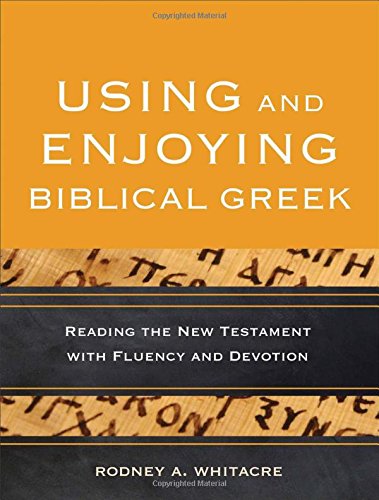 Using and Enjoying Biblical Greek: Reading the New Testament with Fluency and Devotion, by Rodney A. Whitacre (Baker Academic, 2015), 272pp.
Using and Enjoying Biblical Greek: Reading the New Testament with Fluency and Devotion, by Rodney A. Whitacre (Baker Academic, 2015), 272pp.
In chapter one, Whitacre lays out his method and rationale for the work. He begins by encouraging readers of the GNT to do just that: read the GNT. Even if you read only a few passages of the NT at a time, it is vitally important that you start to become familiar and somewhat fluent in your understanding of the GNT. As you become more fluent, you will also start to understand and begin to think as the NT authors. Alongside fluency comes an aspect that is rarely mentioned when learning Greek, it is the art and practice of meditation on what you are reading. As one who spent seven years learning Greek in undergraduate and graduate studies, the thought of meditating on the GNT never crossed my mind.
Chapters two and three serve as a good review on the basics of learning vocabulary and essential parsings. Whitacre provides some excellent steps in building vocabulary as you consistently read through the GNT. He reminds readers to pay close attention to things like suffixes, prefixes, semantic domains, and other lexical elements of the Greek. Chapter three provides the reader with a number of important charts on parsing that serve as a helpful reminder for the rusty student or helpful guide for the new student as he or she continues on the journey of learning Greek.
Chapter four is an excellent guide on how to break down sentences and identify key elements that the author uses. Beginning with the core elements of a sentence, Whitacre builds on them and guides the students through how sentences were constructed and the various elements that make up not only a sentence but also a discourse as well. At the close of the chapter he offers three methods that can be helpful when disambiguating a more complex passage of scripture: chunking, sentence scanning, and sentence mapping.
Moving on to chapter five, Whitacre provides some steps for the student of the GNT to use to gain a familiarity with the GNT. The first step, what he calls puzzling, is to skim through a given portion of scripture to see what is familiar. This will give the reader an idea of what is needed in order to understand what the text says. Whitacre calls the next step scanning. As one’s knowledge of Greek increases, so too does his familiarity with certain aspects of the language. Scanning allows the reader to move more quickly through a text, moving beyond just basic parsing and vocabulary to looking for types or clauses, the use of infinitives and participles, prepositional phrases and other discourse features that are being utilized by the author in his text.
Finally, after scanning the passage comes re-reading the text. Nothing builds fluency like reading and re-reading a text until the reader begins to think in Greek. Quite simply, the goal is not to be able to translate Greek into English but to be able to think in Greek. Whitacre concludes the chapter with a section on helpful aids in building fluency in Greek.
Chapter six is what I consider to be the best chapter of the book. Learning Greek is fun, and there is nothing more exciting than to be able to open up the GNT and begin to work through a passage of sacred Scripture, noticing the unique style of a given author. But the end goal for Christians is not to be able to solve syntactic problems, it is to have the sacred scripture saturate our minds and transform our lives. Whitacre lays out some practical methods for transforming your study of Greek into a time of worship and meditation. He discusses a few methods of meditation to use while reading through the GNT. Helpful is the brief history of meditation in the early church and how the ancient church defined the practice.
At the conclusion of the chapter Whitacre provides some examples of how to utilize meditation in exegesis. I cannot say enough about how useful and needed this chapter is in learning Greek. It is all too easy to get lost in the details of exegesis and syntax and neglect the message and author of sacred Scripture.
The closing chapter offer some practice passages that the reader can work through and apply what he has been taught in the first six chapters. Following this chapter are five appendices: sentence mapping, labels for sentence maps, reader’s notes for John 3:16-18, core patterns for Greek morphology, and Greek verbs—two current topics. Each of the appendices are worth reading through, as they highlight certain aspects earlier discussions.
All in all, Whitacre’s UEBG is a valuable tool for anyone who has taken one year of Greek or one who is a little rusty and wants to return to one’s first love. The format is easy to follow and the examples are good at illustrating points discussed in the book. For someone who has kept their Greek and uses it on a daily basis, I find chapter six alone is worth the price of the book; in fact, this is what initially attracted me UEBG. If you are learning Greek or use Greek daily, this is a book worth having on your shelf and working through.
Preview or buy it here.


One comment